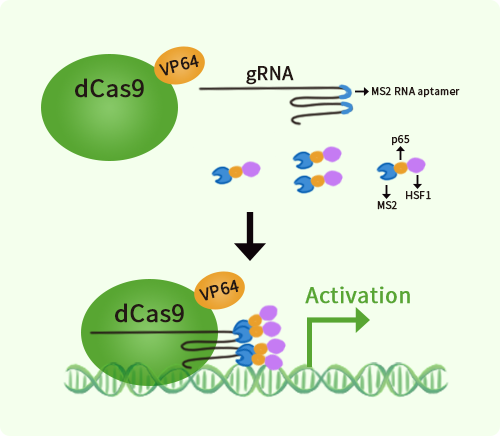Mouse Pou4f2 activation kit by CRISPRa
CAT#: GA203333
Pou4f2 CRISPRa kit - CRISPR gene activation of mouse POU domain, class 4, transcription factor 2
Find the corresponding CRISPRi Inhibitor Kit
USD 1,657.00
2 Weeks*
Specifications
| Product Data | |
| Format | 3 gRNAs (5ug each), 1 scramble ctrl (10ug) and 1 enhancer vector (10ug) |
| Symbol | Pou4f2 |
| Locus ID | 18997 |
| Kit Components | GA203333G1, Pou4f2 gRNA vector 1 in pCas-Guide-GFP-CRISPRa GA203333G2, Pou4f2 gRNA vector 2 in pCas-Guide-GFP-CRISPRa GA203333G3, Pou4f2 gRNA vector 3 in pCas-Guide-GFP-CRISPRa 1 CRISPRa-Enhancer vector, SKU GE100056 1 CRISPRa scramble vector, SKU GE100077 |
| Disclaimer | These products are manufactured and supplied by OriGene under license from ERS. The kit is designed based on the best knowledge of CRISPRa SAM technology. The efficiency of the activation can be affected by many factors, including nucleosome occupancy status, chromatin structure and the gene expression level of the target, etc. |
| Reference Data | |
| RefSeq | NM_138944 |
| UniProt ID | Q63934 |
| Synonyms | Brn-3.2; Brn-3b; Brn3b; mBrn3-3R; Pou4f-rs1 |
| Summary | Tissue-specific DNA-binding transcription factor involved in the development and differentiation of target cells (PubMed:7904822, PubMed:8995448, PubMed:8972215, PubMed:10357904, PubMed:10414983, PubMed:11163266, PubMed:17668438, PubMed:25775587). Functions either as activator or repressor by modulating the rate of target gene transcription through RNA polymerase II enzyme in a promoter-dependent manner (PubMed:7904822, PubMed:7935408, PubMed:8065921, PubMed:7852360, PubMed:7797498, PubMed:8662774, PubMed:9694219, PubMed:10526314, PubMed:15733064, PubMed:17145718, PubMed:18368538). Binds to the consensus octamer motif 5'-AT[A/T]A[T/A]T[A/T]A-3' of promoter of target genes (PubMed:7904822, PubMed:8290353, PubMed:9111308, PubMed:10414983, PubMed:16152597, PubMed:17668438, PubMed:24643061). Plays a fundamental role in the gene regulatory network essential for retinal ganglion cell (RGC) differentiation (PubMed:8632990, PubMed:10357904, PubMed:25775587). Binds to an octamer site to form a ternary complex with ISL1; cooperates positively with ISL1 and ISL2 to potentiate transcriptional activation of RGC target genes being involved in RGC fate commitment in the developing retina and RGC axon formation and pathfinding (PubMed:8995448, PubMed:9261145, PubMed:8972215, PubMed:10357904, PubMed:11163266, PubMed:24643061, PubMed:25775587). Inhibits DLX1 and DLX2 transcriptional activities preventing DLX1- and DLX2-mediated ability to promote amacrine cell fate specification (PubMed:21875655). In cooperation with TP53 potentiates transcriptional activation of BAX promoter activity increasing neuronal cell apoptosis (PubMed:17145718). Negatively regulates BAX promoter activity in the absence of TP53 (PubMed:17145718). Acts as a transcriptional coactivator via its interaction with the transcription factor ESR1 by enhancing its effect on estrogen response element (ERE)-containing promoter (PubMed:9448000). Antagonizes the transcriptional stimulatory activity of POU4F1 by preventing its binding to an octamer motif (PubMed:7935408, PubMed:8065921, PubMed:8537352, PubMed:7852360, PubMed:8662774). Involved in TNFSF11-mediated terminal osteoclast differentiation (PubMed:17668438).[UniProtKB/Swiss-Prot Function] |
Documents
| Product Manuals |
| FAQs |
| SDS |
Resources
Other Versions
| SKU | Description | Size | Price |
|---|---|---|---|
| KN513656 | Pou4f2 - KN2.0, Mouse gene knockout kit via CRISPR, non-homology mediated. |
USD 1,657.00 |
{0} Product Review(s)
Be the first one to submit a review






























































































































































































































































 Germany
Germany
 Japan
Japan
 United Kingdom
United Kingdom
 China
China
